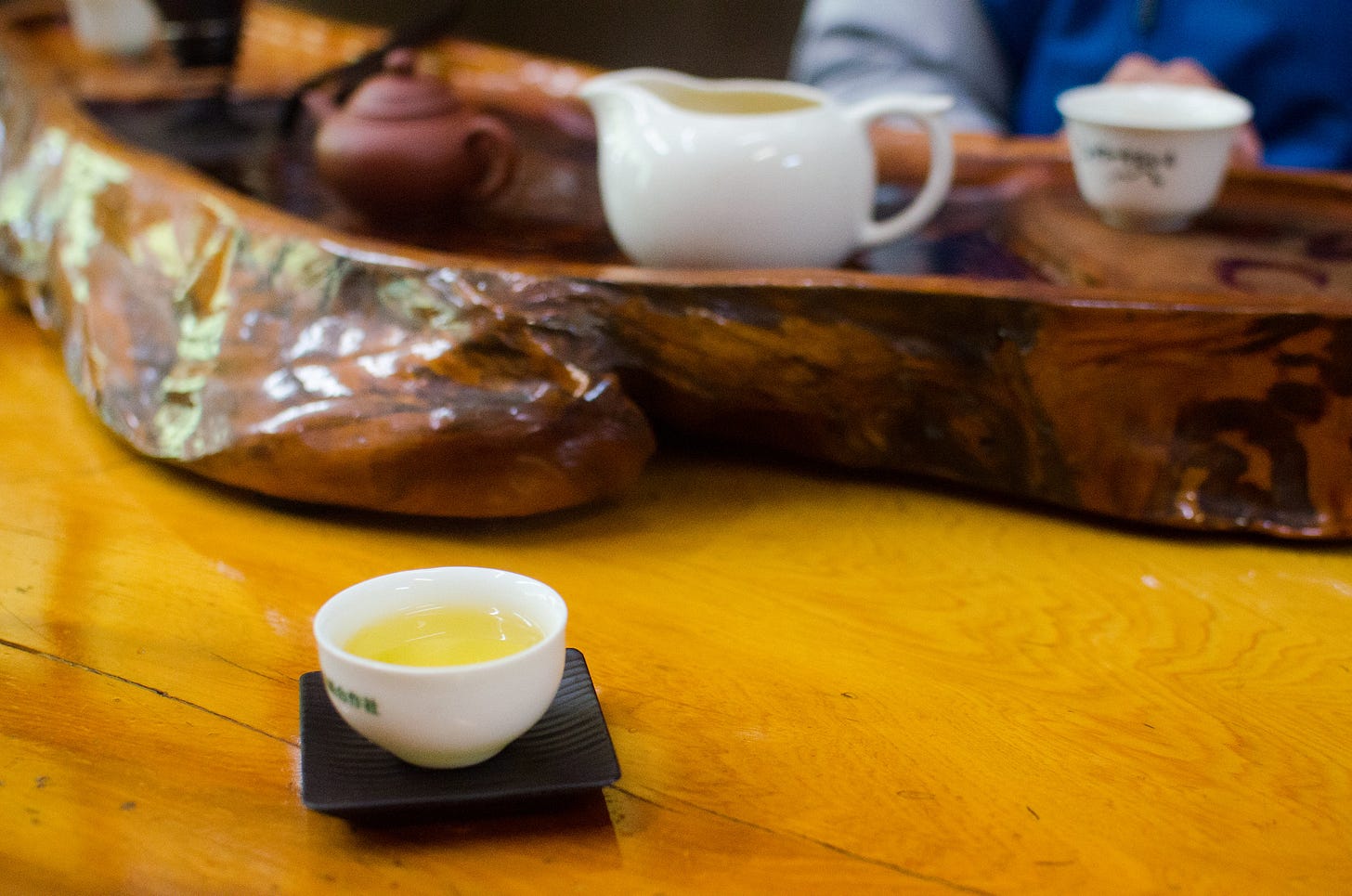What do you look for when tasting tea?
A destination for white tea + paying attention to your mouth.
Benign neglect
The tea: Aged wild white tea, sold by Shang Tea. $50 for 2oz.
I once saw a saying on Twitter—probably cribbed from a t-shirt or some post on Tumblr or Reddit—that “tea tastes like everything is going to be okay.” I think there’s something to it, and today’s tea surely qualifies. At the beginning of the year I recommended aged white tea for cultivating inner peace during a time of outer what-the-fuckery. Here is another fine example that’s worth a small splurge. It’s soothing and peaceful with surprising depth if you let it linger. I’ve been drinking it not just to feel okay, but to perceive a mote of optimism about the future.
The “wild” in this tea’s name refers to a field that was planted “between the 1960s and early ‘80s,” according to Shang, and abandoned in the late ‘90s. Minimal plucking resumed in 2007, but this autumn 2010 harvest represented the first major intervention in the garden’s growth. Like any other perennial crop, regular plucking and pruning takes its toll on a tea plant. When a field is allowed to grow wild, the plants gain a vigor you can taste in the leaves. Strongman Samson didn’t get monthly haircuts.
The source: Kansas City’s Shang Tea has a well deserved reputation for the quality of its white teas. The mononymous founder Shang started the company in 2005 and opened a tea room in 2007. Fortunately, that space has survived 2020’s teahouse mass extinction event, serving tea to go and in-person tastings by appointment. In addition to an impressive selection of fresh and aged white teas, Shang offers enticing green and oolong teas that are also grown in Fujian. Narrow regional focus has allowed them to go deep on what they’re good at. For a lower cost white tea with some age, check out their shou mei.
To brew: Unlike many aged white teas, this one is closer to a bai mudan grade, meaning it only uses the unopened bud and top two leaves. I suspect that’s one reason it exhibits rose and jasmine aromas through repeated steepings. 15 years of aging have contributed a grounded, earthy character that dances around its lofty aromatics. The texture is superb. Slick and buoyant, it sticks with you cup after cup. You can emphasize that texture by using water around 195°F, but I prefer the fuller flavor that comes from boiling temperatures. Try 5 to 7 grams in a 150 milliliter pot and steep for 20 to 30 seconds at first, lengthening as you go. This complex tea rewards long steeps and patient drinking.
Ask a Tea Person: What do you look for when tasting tea?
Welcome back to of Ask a Tea Person, Leafhopper’s tea advice column. Check out previous editions here, and submit your own questions by emailing max.falkowitz@gmail.com with “Ask a Tea Person” in the subject line.
Love your tasting notes, but when I try to taste tea it just tastes like…tea. What am I missing? How can I get better at tasting the nuances in tea? — Masha R.
Masha, I feel you. The concept of detecting flavors sends me spiraling into an epistemological crisis. I can describe a tea’s aroma with words like rose and jasmine, but what kind of rose? How do I know what roses you’ve smelled? How do I know this tea smells like roses that I’ve smelled versus my idea of what roses are? Human language relies on metaphor in a way that math does not. The number 1 is the same for you and for me. With words, we’re all fumbling in the dark, even when communicating with ourselves.
This is especially the case with taste. Our tastebuds can only detect broad sensations like sweet, sour, and salty. All the finer points—notes of jasmine and rose—come from what we smell, and our sense of smell may be the most lizard-brain way we experience the world. Unlike vision, taste, touch, and sound, smell bypasses the part of the brain that initially triages sensory information, instead making a beeline for regions associated with emotion and memory. Smell—and by extension how we taste—is inherently embodied, contextual, and mutable. So what if we dispense with words altogether?
Keep reading with a 7-day free trial
Subscribe to Leafhopper to keep reading this post and get 7 days of free access to the full post archives.








